小学英语《Unit 1 Were you at home yesterday》优质课教学设计、教案
- 格式:docx
- 大小:14.00 KB
- 文档页数:6
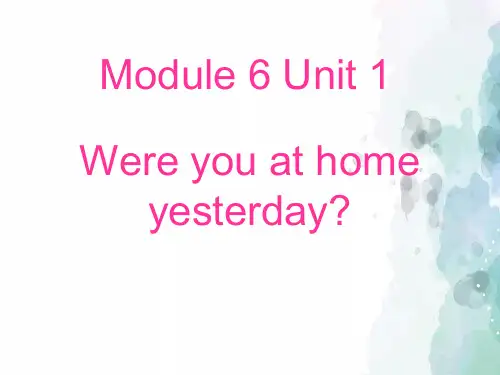
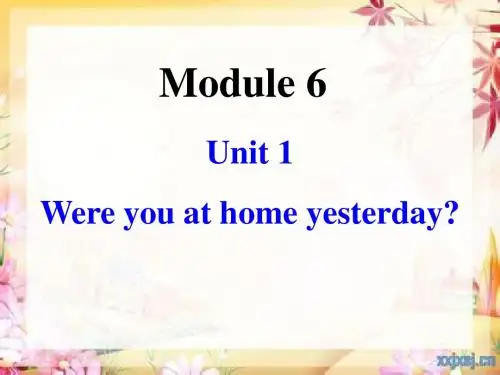
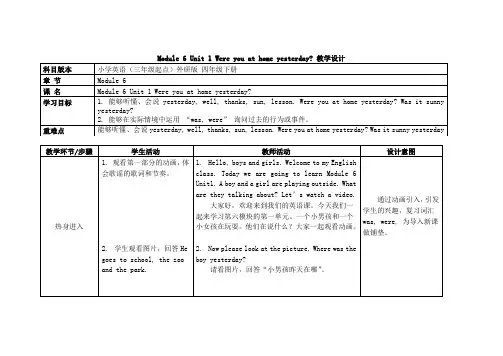
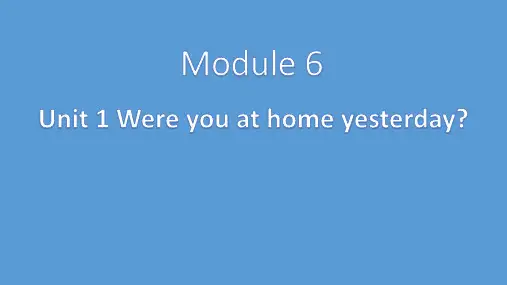
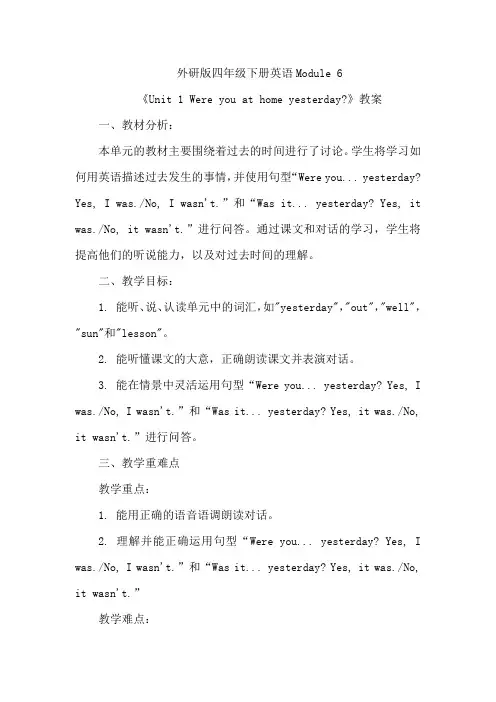
外研版四年级下册英语Module 6《Unit 1 Were you at home yesterday?》教案一、教材分析:本单元的教材主要围绕着过去的时间进行了讨论。
学生将学习如何用英语描述过去发生的事情,并使用句型“Were you... yesterday? Yes, I was./No, I wasn't.”和“Was it... yesterday? Yes, it was./No, it wasn't.”进行问答。
通过课文和对话的学习,学生将提高他们的听说能力,以及对过去时间的理解。
二、教学目标:1. 能听、说、认读单元中的词汇,如"yesterday","out","well","sun"和"lesson"。
2. 能听懂课文的大意,正确朗读课文并表演对话。
3. 能在情景中灵活运用句型“Were you... yesterday? Yes, I was./No, I wasn't.”和“Was it... yesterday? Yes, it was./No, it wasn't.”进行问答。
三、教学重难点教学重点:1. 能用正确的语音语调朗读对话。
2. 理解并能正确运用句型“Were you... yesterday? Yes, I was./No, I wasn't.”和“Was it... yesterday? Yes, it was./No, it wasn't.”教学难点:句型操练:1. "Were you... yesterday? Yes, I was./No, I wasn't."2. "Was it... yesterday? Yes, it was./No, it wasn't."四、学情分析:学生是四年级的学生,他们已经学习了一些基础的英语知识,如基本的问候语和日常用语。
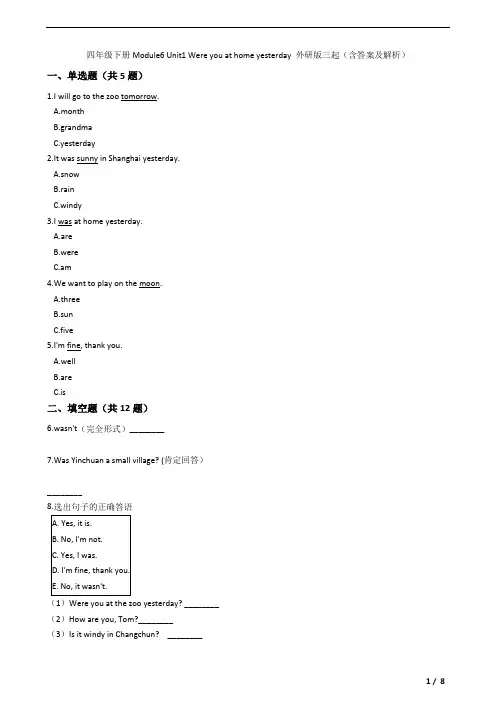
四年级下册Module6 Unit1 Were you at home yesterday 外研版三起(含答案及解析)一、单选题(共5题)1.I will go to the zoo tomorrow.A.monthB.grandmaC.yesterday2.It was sunny in Shanghai yesterday.A.snowB.rainC.windy3.I was at home yesterday.A.areB.wereC.am4.We want to play on the moon.A.threeB.sunC.five5.I'm fine, thank you.A.wellB.areC.is二、填空题(共12题)6.wasn't(完全形式)________7.Was Yinchuan a small village? (肯定回答)________8.选出句子的正确答语(1)Were you at the zoo yesterday? ________(2)How are you, Tom?________(3)Is it windy in Changchun? ________(4)Was it sunny in Tianjin? ________(5)Are you at school now? ________9.找出下列不同类型的单词。
① ________ A. sun B. sunny C. windy② ________ A. well B. fine C. rain③ ________ A. Monday B. Saturday C. lesson10.按要求写词汇。
① big(反义词)________ ② old(反义词)________ ③ fat(反义词)________11.按要求写词汇。
① is(过去式)________ ② are(过去式)________ ③ now(对应词)________12.找出下列不同类型的单词。
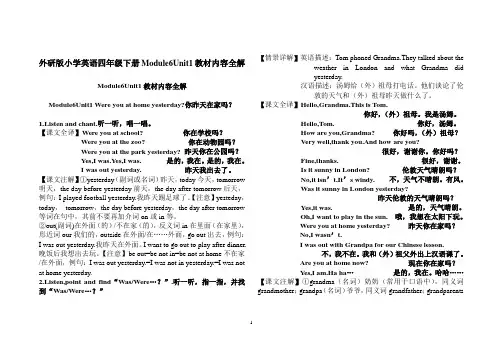
外研版小学英语四年级下册Module6Unit1教材内容全解Module6Unit1教材内容全解Module6Unit1 Were you at home yesterday?你昨天在家吗?1.Listen and chant.听一听,唱一唱。
【课文全译】Were you at school? 你在学校吗?Were you at the zoo? 你在动物园吗?Were you at the park yesterday? 昨天你在公园吗?Yes,I was.Yes,I was. 是的,我在。
是的,我在。
I was out yesterday. 昨天我出去了。
【课文注解】①yesterday(副词或名词)昨天,today今天,tomorrow 明天,the day before yesterday前天,the day after tomorrow后天,例句:I played football yesterday.我昨天踢足球了。
【注意】yesteday,today,tomorrow,the day before yesterday,the day after tomorrow 等词在句中,其前不要再加介词on或in等。
②out(副词)在外面(的)/不在家(的),反义词in在里面(在家里),形近词our我们的,outside在外面/在……外面,go out出去,例句:I was out yesterday.我昨天在外面。
I want to go out to play after dinner.晚饭后我想出去玩。
【注意】be out=be not in=be not at home不在家/在外面,例句:I was out yesterday.=I was not in yesterday.=I was not at home yesterday.2.Listen,point and find“Was/Were…?”.听一听,指一指,并找到“Was/Were…?”【情景详解】英语描述:Tom phoned Grandma.They talked about theweather in London and what Grandma didyesterday.汉语描述:汤姆给(外)祖母打电话。
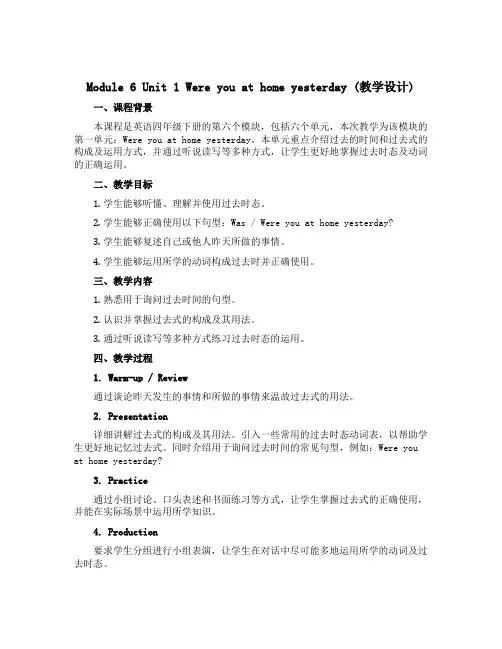
Module 6 Unit 1 Were you at home yesterday (教学设计)一、课程背景本课程是英语四年级下册的第六个模块,包括六个单元,本次教学为该模块的第一单元:Were you at home yesterday。
本单元重点介绍过去的时间和过去式的构成及运用方式,并通过听说读写等多种方式,让学生更好地掌握过去时态及动词的正确运用。
二、教学目标1.学生能够听懂、理解并使用过去时态。
2.学生能够正确使用以下句型:Was / Were you at home yesterday?3.学生能够复述自己或他人昨天所做的事情。
4.学生能够运用所学的动词构成过去时并正确使用。
三、教学内容1.熟悉用于询问过去时间的句型。
2.认识并掌握过去式的构成及其用法。
3.通过听说读写等多种方式练习过去时态的运用。
四、教学过程1. Warm-up / Review通过谈论昨天发生的事情和所做的事情来温故过去式的用法。
2. Presentation详细讲解过去式的构成及其用法。
引入一些常用的过去时态动词表,以帮助学生更好地记忆过去式。
同时介绍用于询问过去时间的常见句型,例如:Were you at home yesterday?3. Practice通过小组讨论、口头表述和书面练习等方式,让学生掌握过去式的正确使用,并能在实际场景中运用所学知识。
4. Production要求学生分组进行小组表演,让学生在对话中尽可能多地运用所学的动词及过去时态。
5. Consolidation对本课程所学知识的总结复习、策略分享以及不足之处的反思。
6. Homework布置家庭作业,要求学生通过写作或口头表述的方式,回答下列问题:What did you do yesterday?五、评价方式1.平时教学表现评价2.小组表演评价3.书面作业评价六、教学资源1.本课程所需的教学资料:黑板、白板、投影等设备。
2.过去时态动词表。
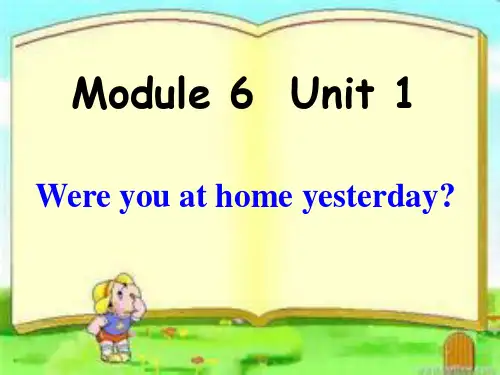
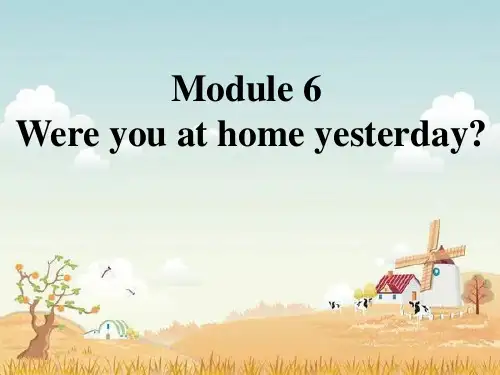
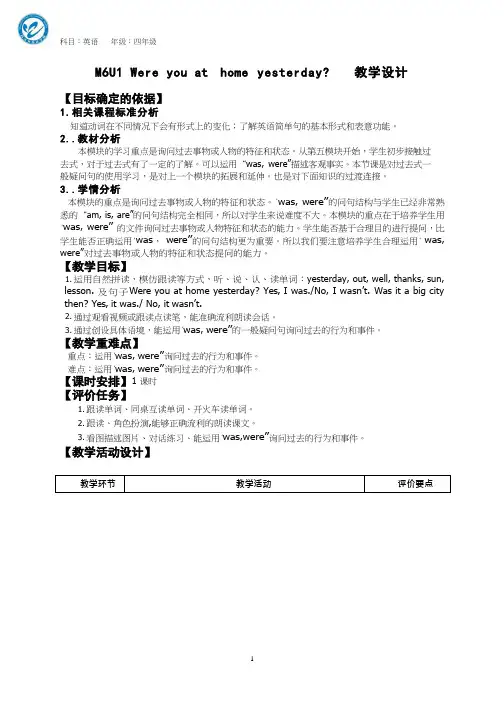
M6U1 Were you at home yesterday? 教学设计【目标确定的依据】1.相关课程标准分析知道动词在不同情况下会有形式上的变化;了解英语简单句的基本形式和表意功能。
2..教材分析本模块的学习重点是询问过去事物或人物的特征和状态。
从第五模块开始,学生初步接触过去式,对于过去式有了一定的了解。
可以运用“was, were”描述客观事实。
本节课是对过去式一般疑问句的使用学习,是对上一个模块的拓展和延伸。
也是对下面知识的过渡连接。
3..学情分析本模块的重点是询问过去事物或人物的特征和状态。
“w as,w e r e”的问句结构与学生已经非常熟悉的“am, is, are”的问句结构完全相同,所以对学生来说难度不大。
本模块的重点在于培养学生用“w as,w e r e”的文件询问过去事物或人物特征和状态的能力。
学生能否基于合理目的进行提问,比学生能否正确运用“w as,w e r e”的问句结构更为重要。
所以我们要注意培养学生合理运用“w as, were”对过去事物或人物的特征和状态提问的能力。
【教学目标】1.运用自然拼读,模仿跟读等方式,听、说、认、读单词:yesterday, out, well, thanks, sun, lesson. 及句子Were you at home yesterday? Yes, I was./No, I wasn’t. Was it a big city then? Yes, it was./ No, it wasn’t.2.通过观看视频或跟读点读笔,能准确流利朗读会话。
3.通过创设具体语境,能运用“w as,w e r e”的一般疑问句询问过去的行为和事件。
【教学重难点】重点:运用“w as,w e r e”询问过去的行为和事件。
难点:运用“w as,w e r e”询问过去的行为和事件。
【课时安排】1 课时【评价任务】1.跟读单词、同桌互读单词、开火车读单词。
Unit 1 Were you at home yesterday?一、选出与句中画线单词同类的一项。
( ) 1. I will go to the zoo tomorrow.A. monthB. grandmaC. yesterday ( ) 2. I’m fine, thank you.A. wellB. areC. is( ) 3. We want to play on the moon.A. threeB. sunC. five( ) 4. It was sunny in Shanghai yesterday.A. snowB. rainC. windy( ) 5. I was at home yesterday.A. areB. wereC. am二、红花配绿叶。
(将花中的字母与叶子中的字母连起来,组成完整的单词)1. 2. 3. 4. 5.A B. C. D. E.三、将下列图片与对应的短语连起来。
1. A. at the park2. B. at school3. C. at home4. D. at the zoo5. E. in the library四、用所给单词的正确形式填空。
1. I ________ (be) at school yesterday.2. ________ (be) you at home yesterday?3. I want ________ (play) football this afternoon.4. —How ________ (be) you?—I’ m fine, thanks.5. It was ________ (sun) in Beijing yesterday.五、从Ⅱ栏中选出Ⅰ栏中句子的正确答语。
ⅠⅡ( ) 1. Were you at the zoo yesterday? A. Yes, it is.( ) 2. How are you, Tom? B. No, I’m not.( ) 3. Is it windy in Changchun? C. Yes, I was.( ) 4. Was it sunny in Tianjin? D. I’m fine, thank you. ( ) 5. Are you at school now? E. No, it wasn’t.答案:一、1. C 2. A 3. B 4. C 5. B二、1. C 2. A 3. E 4. B 5. D三、1—C 2—B 3—A 4—E 5—D四、1. was 2. Were 3. to play 4. are 5. sunny五、1. C 2. D 3. A 4. E 5. B小学教育资料好好学习,天天向上!第4 页共4 页。
小学英语教案四年级下册Module6Unit1 Were you at homeyesterday 外研版三起一、教学目标1.掌握句型:Were you at home yesterday?2.能够用所学句型进行简单的日常交际。
3.较好的朗读课文,理解课文大意。
4.掌握所学单词和短语,比如:yesterday,home,watch TV等。
5.能在实际生活中运用所学知识,比如能流利询问别人的昨天的活动情况。
二、教学重、难点教学重点:掌握所学句型,并能进行口语交际。
教学难点:正确运用句型,进行语言表达。
三、教学策略词汇读音教学,问答练习,游戏形式交流四、教学过程1. 热身播放英文歌曲或英文动画片。
2. 学习新知(1)介绍Were you at home yesterday?老师出示图片,询问学生昨天在哪里?What did you do yesterday? Were you at home yesterday?(2)听读播放课文,让学生听课文并跟读。
(3)边读边学根据课文内容,将关键词和短语显示在黑板上,让学生朗读并熟悉单词和短语的发音和含义。
(4)问答练习老师示范用Were you at home yesterday?询问别人的活动情况,并要求学生进行相互问答练习。
(5)小组游戏将学生分组,让他们通过游戏形式完成教学任务。
比如让学生站成一排,相互问答,每回答一道问题,即向后移动一步,最终走到终点的队伍获胜。
3. 作业布置请学生在家中复习所学知识,并找一个伙伴进行练习。
五、教学反思通过本节课的教学,学生能够掌握所学知识并运用到实际生活中。
在教学过程中,边读边学和小组游戏这两种教学方式都取得了良好的效果,让学生在轻松愉快的氛围中学习英语,加深了他们对所学内容的理解和记忆。
另外,教师需要注意及时纠正学生口语表达中的错误,以保证学生在学习过程中不会形成错误的语言习惯。
教材分析:Module 6Unit 1 were you at home yesterday 教学设计外研社新标准(三起)第四册Module 6 Unit 1 第一单元的课文情境是Tom 给远在英国的奶奶打电话。
电话中,Tom 先问了奶奶伦敦今天和昨天的天气状况,接着又询问了奶奶昨天是否在家。
奶奶告诉Tom 昨天自己和爷爷去上汉语课,于是接着问奶奶现在在不在家,奶奶大笑。
原来Tom 是和奶奶用座机在通话,奶奶当然在家里,而Tom 还太小,不太明白,所以才会问出这样的问题。
教学思路:四年级的学生,虽然有一年的英语基础,可是在自由表达方面还存在困难,我从学生的知识和生活环境出发多方面考虑,在教学环节设计上由易到难,环环相扣,层层递进,让学生在潜移默化中轻松掌握和巩固知识以及文化技能。
教学方法:听说法,情景教学法,任务教学法。
教学目标:1语言知识目标: 能听、说、认读本课的重点单词:yesterday、out,well,thanks, sun, lesson, ;全体学生能运用Were you at home yesterday?谈论过去事物或人物的特征和状态。
感知一般疑问句的语音语调特质。
2语言能力目标: 能根据课件、图片展示听、说相应的单词;能根据设计的场景运用Were you at home yesterday?询问过去实物或人物的特征和状态。
3情感、策略和文化目标:巩固英语中的称谓语和问候语,使学生乐于感知和积极尝试使用英语,鼓励学生积极合作学习,突破学习重难点。
教学过程:Step 1 warming up1.Greetings.师生相互问好。
2.Sing a song.《I was fat.》学生边跳边做,激发了学生的兴趣,活跃了课堂气氛。
3.Free talk:T:What’s the weather like today?Ss:It’s sunny.T:How about yesterday? Was it sunny yesterday?(通过询问今天的天气,引出昨天的天气,从而巩固一般过去时态。
)T:Do you know where I was yesterday? Can you guess?S1:...?S2:...?S3:...?T:Yesterday was sunny,so I was at school at first. After school,I went to the zoo,and then I went to the park.I was not at home.So I can say:I was out yesterday.(新授out)T:How about you? Were you at home yesterday?S1:Yes, I was.S2:..........T:Great!And this class,we will learn Module 6 unit 1 Were you at home yesterday?(学生读课题)Step 2 Task Presentation完成活动一:1.呈现图片,请学生向小男孩提问题。
T: Have you got any questions to ask the little boy?S1:Were you at home/the zoo/the park/school?T:OK,now let’s watch the video and find the answer.2.播放动画,让学生整体感知,再次播放,寻找答案。
3.播放录音,逐句跟读。
Were you at home yesterday?Were you at school yesterday?Were you at zoo yesterday?Yes I was. yes I wasI was out yesterday.本课我们继续用was /were 来谈论过去的事物或人物的特征和状态。
Step 3 Text learning1.Free talk:出示活动二第一幅图片T:Who are they?Ss:They are Tom and his grandma.T:What are they doing now?Ss:They are talking on the phone.T:Where is grandma now?Ss:In London.T:Do you know the weather in London?Now let’s watch the video and find the answer.2.W atch and answer.Questions:1、I s it sunny in London?No, it isn’t.2、Was it sunny in London yesterday ? Yes, it was.3.L isten and answer.Questions:1.Were you at home yesterday?2.Are you at home now?4.L isten and repeat.(逐句跟读,注意语音语调)通过单词卡片、图片学习(well,thanks,sun,lesson)5.R ead with your partener.同位分角色朗读课文,注意语音语调。
6.Role play.同位两个上台表演对话。
Step 4 Practise完成活动四。
1.出示活动四图片,教师示范引导学生理解活动要求。
T:This time,let’s check what you can say after our studying.Who can practise with me first?(师示范)T:Were you at home/cinema/shop/school yesterday?S1:Yes, I was./No,I wasn’t.2.学生两人一组练习。
3.展示对话。
Step5.Learn to useMake a survey1.教师引导学生理解调查要求。
T:Just now,we know that they were in different places yesterday.Now let’s make a suevey. Look, you can choose a little reporter in your group. The reporter asks:“Were you ... yesterday?”,and others answer with“Yes,I was.”or“No,I wasn’t.”.The reporter should ask and fini sh the table,and then report.2.四人一组,完成调查。
3.Little reporter 展示调查结果。
Step 6. SummaryT:What did you learn this class?Words:yesterday,out,well,sun,lessonSentences:Was it sunny in London? Yes,it was./No,it wasn’t. Wereyou at home yesterday?Yes,it was./No,it wasn’t.Step 7.Homework1.Listen and read the dialogue,try to imitate and retell the dialogue.2.Make a survey of where your family were yesterday.板书设计M6U1 Were you at home yesterday?Were you ... yesterday?Yes ,I was / No, I wasn’t.教学反思在本课的设计上,我从学生的知识和生活环境出发多方面考虑,在教学环节设计上由易到难,环环相扣,层层递进,让学生在潜移默化中轻松掌握和巩固知识。
在本课的设计主要运用了“任务型”教学法,在教学中采用多样化的教学手段将听、说、玩、演溶于一体,激发学生学习英语的兴趣和愿望。
在教学中有几个亮点:1、创设情境,激发兴趣热身环节通过唱一唱,说一说,猜一猜等游戏活动充分调动起学生兴趣。
本堂课一开始,我就带领学生边动作边唱《I was fat.》这首歌,使学生的注意力在最短的时间里被激活。
接着利用Free talk 引出新词教学,自然而有效。
然后再通过猜地点活动复习地点词并对应分组激励学生。
2、教学活动的设计有效,具有层次性。
整堂课活动设计有层次性,教学过程中注重环节与环节之间的有机联系,精心设计,自然导入,做到环环相扣,步步为营,使学生真正做到学以致用。
(1)通过动画1 导入新句型“Were you…yesterday?”的学习,再通过猜猜老师在哪儿这个游戏活动引导学生运用该句型。
(2)课文的学习则很好地贯彻了四年级听说课的原则:以“听”为基础,发展学生说的能力。
第一步,抓住课文主线watch and listen ,then anwer:Where was grandma?第二步,Listen and answer the questions.通过听回答关于天气的两个问题。
并顺势教授“Was it…yestrerday?”的句型。
第三步,听并回答“Were you at home yesterday?”。
第四步,跟读课文然后进行角色扮演。
(3)Practise 有效巩固训练本课主要句型。
拓展活动则采用了“小记者采访”的形式,由小组长充当小记者根据情景用所学句型采访组内成员。
很好地结合了具体情境练习了本课的目标语句,使学生在用中学,学中用。
3、充分利用单词卡片,结合多媒体课件教学,为学生提供真实的画面,利于学生对英语的感知,理解吸收和消化,同时也激发学生的学习动机培养学生的学习兴趣。
整堂课气氛较活跃,学生勇于参加,体现了学生是主体的地位。
4、采用丰富的肢体语言,指令有效,能够及时评价学生,激发学生主动参与的热情。
本课的缺憾之处:在教授单词lesson, sun 时没能够及时地板书,对句型Was it…yesterday? Yes, it was./ No,it wasn’t.操练不够充分。
课文的教授处理得很好,如能对整篇课文进行一下梳理,效果会更好!。